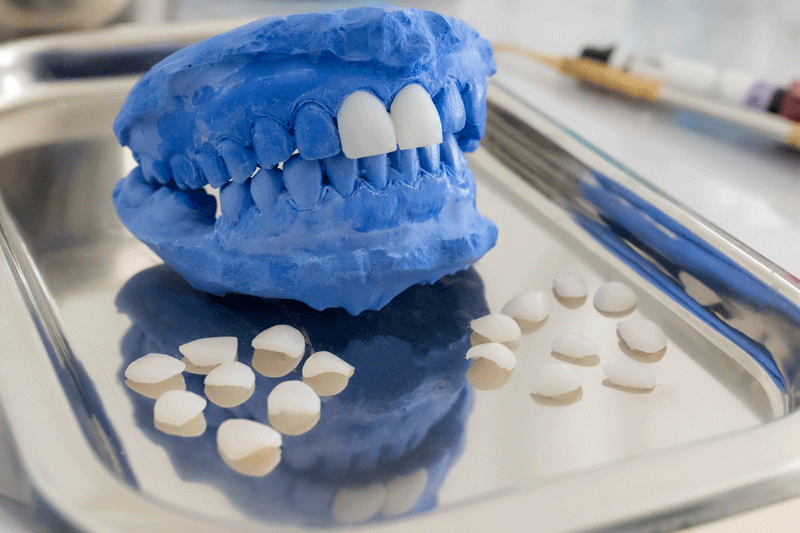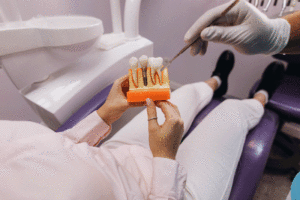Veneer Removal Explained: Process, Challenges, and Alternatives
Veneers are a popular cosmetic solution for transforming smiles, but we’re often asked: Can veneers be removed? The answer depends on your type of veneers and your long-term dental goals.
Are Veneers Permanent?
Traditional porcelain veneers are an irreversible treatment. The process involves removing some enamel to ensure a proper fit, meaning once they are placed, you will always need veneers or restorations to protect your teeth.
In contrast, no-prep veneers, such as Lumineers, involve minimal or no enamel removal. If desired, they can be removed, but some adjustments may still be needed to restore the natural teeth underneath.
Why Someone Would Want to Remove Veneers?
The following are some reasons why to consider removing veneers:
- Wear and Tear: Veneers last 10-15 years but can chip or wear down.
- Discoloration: While porcelain veneers resist stains, the bonding material may discolor.
- Gum Recession: If gums recede, veneers may no longer fit, requiring adjustments or replacements.
- Aesthetic Changes: Some clients may desire a different shape, size, or hue for their veneers.
- Underlying Tooth Issues: Decay, damage, or other oral health concerns may necessitate veneer removal.
What Transpires After Veneers Are Removed?
If traditional veneers are removed, the natural teeth structure will be sensitive and vulnerable due to the enamel removal. In most cases, replacement veneers or another restorative option (such as crowns) will be required.
With no-prep veneers, removal may not always require instant restoration, but it’s essential to consult your dentist before making changes.
What If Veneers Need to Be Replaced?
If veneers are damaged, worn, or outdated, your dentist can replace them with new ones. Dental check-ups ensure the veneers remain in optimal condition and that necessary replacements are handled professionally.
The Veneer Removal Process
If the veneers are no-prep or minimal-prep, they may be lifted off without significant enamel loss. For traditional veneers that required enamel reduction, removal necessitates replacing them with new veneers or an alternative restoration. Your dentist will use specialized tools to break the bond between the veneer and the tooth, ensuring minimal damage. After removal, the teeth are assessed, and the next steps—such as placing new veneers or another cosmetic treatment—are planned based on the client’s dental health, budget, and aesthetic goals.
What Happens to Teeth After Veneers Are Removed
If no-prep or minimal-prep veneers were used, the natural teeth may remain intact, though they might be rough or discolored due to the bonding process. If the veneers required enamel reduction, the exposed teeth may feel sensitive, appear uneven, and lack their original enamel layer. In most cases, dentists recommend replacing the veneers or choosing an alternative restoration to protect the teeth and maintain an aesthetical smile.
Do Teeth Return to Their Original state After Veneers Are Removed?
In most cases, teeth do not return to their pre-veneer condition due to enamel reduction. While enamel does not regenerate, proper dental care and treatments can improve the appearance and function of teeth.
Managing Sensitivity and Oral Health After Veneer Removal
Following veneer removal, teeth may be more sensitive, but proper care can minimize discomfort and protect oral health.
- Reducing Sensitivity: Use desensitizing toothpaste and fluoride treatments; avoid hot or cold foods and beverages.
- Proper Oral Care Practices: Maintain brushing and flossing routines; schedule dental checkups.
- Professional Treatments: Fluoride applications and sealants can protect exposed enamel.
Alternative Treatments After Veneer Removal
Although veneer removal can alter the look and feel of teeth, several alternative restorative options are available.
- Replacement Veneers: Many clients opt to replace their veneers to maintain a polished appearance.
- Dental Bonding: A cost-effective option that restores the shape and color of teeth post-removal.
- Crowns: Recommended for teeth that need additional support and coverage.
- Orthodontic Treatment: If alignment issues exist, braces or Invisalign may be considered.
What Treatments Do Not Remove Enamel?
For those seeking aesthetic improvements without veneers, options include:
- No-Prep Veneers: A less invasive alternative.
- Teeth Whitening: Ideal for enhancing natural tooth hue.
- Cosmetic Bonding: Provides a minimally invasive enhancement.
- Orthodontic Treatment: Corrects alignment issues without altering enamel.
Cost Considerations for Veneer Removal and Restoration
The price of veneer removal and subsequent treatments can vary based on the type of veneers, the condition of the underlying teeth, and the chosen restoration method.
Breakdown of Fees
- Veneer Removal: $100–$500 per tooth.
- Replacement Veneers: $800–$2,500 per tooth.
- Dental Bonding: $300–$600 per tooth.
- Crowns: $1,000–$3,000 per tooth.
Final Thoughts
While veneers can technically be removed, traditional veneers require a permanent commitment. If you’re considering veneers or need a replacement, Smile Design Dentistry in Plymouth can guide you through the best options for your smile. Learn more about the longevity and care of veneers and schedule a consultation!
FAQs About Veneer Removal
Can you get your natural teeth back after veneers?
Not if enamel was removed during placement.
Does veneer removal damage teeth?
It depends on the type of veneers used, but traditional veneers cause permanent enamel loss.
How long does sensitivity last after veneers are removed?
Sensitivity may persist for a few weeks to months, depending on enamel thickness.
What is the best alternative to veneers?
Cosmetic bonding, whitening, and orthodontics are effective non-invasive options.
Will my teeth be fragile after veneer removal?
Teeth may be more delicate due to reduced enamel, but proper dental care can strengthen them.




